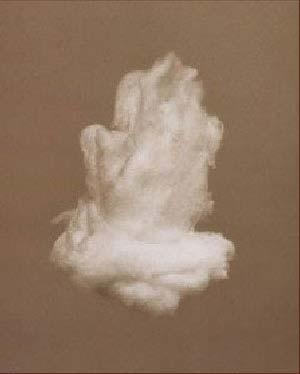
|
|
|
Vik Muniz:
Manipulator of Positives
|
|
"The telling of beautiful untrue things is the proper aim of art."
—Oscar Wilde 1
|
|
Vik Muniz
Boys of Carnival
(Aftermath Series: Madalena)
60" x 48" Cibachrome
Copyright the artist, courtesy of Pan American Art Gallery
|
|
|
Vik Muniz's most recent body of work, Aftermath, consists of a series of oversized color photographs of dirt and waste. The eye meandering through these all-over dispersions it trips over seemingly left-behind yet carefully placed signs of party and euphoria — cigarette butts, crumbled confetti and paper ribbons, soiled feathers, discarded can tabs, all mixed with soil and gravel. On second look, however, one identifies, in the negative spaces formed by the more rarefied areas of litter accumulation, full and half-length portraits of young children, their semblance fairly naturalistically rendered
|
|
Anyone familiar with Muniz's typically laborious, elaborate — and somewhat dopey — working process knows that he can go to great lengths to invest his photographs with a particular state of perceptual suspension and an uncanny sense of wonderment. For Aftermath he took black-and-white Polaroid shots of six-to-ten-year-old abandoned children in the streets of his native São Paulo. Back in his New York studio, with the aid of a light box and a paraphernalia of home tools, including customized sieves, mini vacuum cleaners, brushes, toothpicks, and wire, combined with punctilious draftsmanship, he proceeded to re-create these portraits by allowing modulated amounts of light through the layer of rubbish. In an attempt to move away from the sensationalist appeal inherent in images of homeless children, Muniz picked among his Polaroids those that would embody a sense of the stereotypical, of the emblematic, of a common register. In this sense, the end results portray an anonymous "Emerson," "Aparecida," "Sócrates," and "Madalena" (or so the photographs are titled) — yet these children are rendered with the dignity and sumptuous scale of a Van Dyck or a Velasquez.
|
|
|
|
| |
 |
| |
Vik Muniz, Dürer's Praying Hands (Equivalent Series). 1993.
Copyright the artist.
|
Muniz's photographs are famously suspect. And to concede a glimpse of how they were made is partially to give them away. What is the difference between a puddle of chocolate syrup accidentally forming the likeness of Freud and a drawing of a portrait of Freud in chocolate syrup? Muniz's images not only continuously speak to this ambiguity but are indeed fueled by it. His fascination with the transience of form recognition, with the eye's ready disposition to use only the slightest clues in order to make up an image, permeates virtually all of his work. This self-professed "low tech illusionist" likes to superimpose layers of representation, and derives great pleasure in fooling the eye's mind. He has photographically documented some of his "findings": a cow whose markings form another cow facing the other way; yards of thread configuring landscape views á la Corot; clouds in the shape of praying hands, snails, and airplanes; soil arrangements outlining fragments of the human anatomy; and sugar disposed against a dark background featuring portraits of children. So, in the case of Aftermath, who is to say that Muniz did not scour the hungover streets on Ash Wednesday detecting in the scattered post-carnivalesque detritus the seemingly miraculous, shroud-like apparitions of young children? In the staging of his photographs, Muniz is as careful to show the signs of his process as to leave open the possibility of chance, not to mention a found configuration. Which medium other than photography would lend itself so ideally to this task? As the privileged means of documenting evidence, photography's long-standing claim to truth could not be a more suitable cover for a lie.
|
|
1 Oscar Wilde, The Decay Of Lying - An Observation (1898).
|

